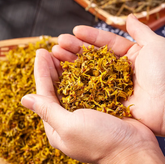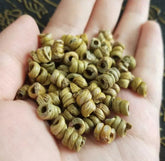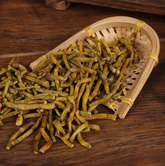Cistanche - One of the Nine Noble Herbs
Cistanche belongs to the family Orobanchaceae. It is a parasitic plant that lacks chlorophyll and cannot perform photosynthesis independently like most green plants. Instead, it attaches to the roots of host plants, primarily desert shrubs like Haloxylon ammodendron and other salt-tolerant species, to obtain nutrients and water. The plant typically has a stout, fleshy stem that ranges from yellowish-brown to brown in color. The stem shape varies from cylindrical to slightly flattened and often grows substantially underground before emerging. The flowers are typically tubular or funnel-shaped, ranging in color from pale yellow to purple, and cluster in spike-like inflorescences at the stem tip.
In traditional Chinese medicine, Cistanche has been highly valued for thousands of years. It has a sweet and salty taste with a warm nature. It acts on the kidney and large intestine meridians.
It is renowned for tonifying kidney yang and is commonly used to address kidney deficiency symptoms. It also moistens the intestines to relieve constipation, benefiting intestinal function in cases of intestinal dryness or difficulty with bowel movements due to constitutional weakness.
Cistanche can be used in several ways. It can be prepared as a decoction by boiling with water and other herbs to extract its medicinal compounds. Dried Cistanche slices are popularly brewed as tea for daily consumption to obtain its health benefits. It is also processed into health products such as capsules or extracts for convenient use.
In Chinese culture, Cistanche has long been associated with health and vitality. It is documented in numerous ancient medical texts and folk prescriptions, representing the wisdom of traditional Chinese medicine in using natural plants to maintain health and treat diseases. Moreover, its unique desert habitat represents life's tenacity in harsh environments and has become a topic of interest in cultural and ecological discussions.
Modern research has identified various bioactive compounds in Cistanche , including phenylethanoid glycosides, iridoids, and polysaccharides. Studies indicate these compounds possess pharmacological effects including immune enhancement, improved male reproductive function, and nervous system protection. For example, phenylethanoid glycosides demonstrate antioxidant and anti-inflammatory properties that help address various health issues and support overall wellness.
However, like many valued medicinal plants, Cistanche faces challenges including overharvesting due to its high medicinal value. Consequently, conservation efforts include establishing protected areas and promoting artificial cultivation to ensure sustainable use and preserve its ecological and medicinal value.
In summary, Cistanche is a remarkable plant that integrates unique ecological adaptations, significant medicinal functions, and rich cultural meaning, making it valuable to traditional Chinese medicine and worthy of continued modern research.
- Choosing a selection results in a full page refresh.







